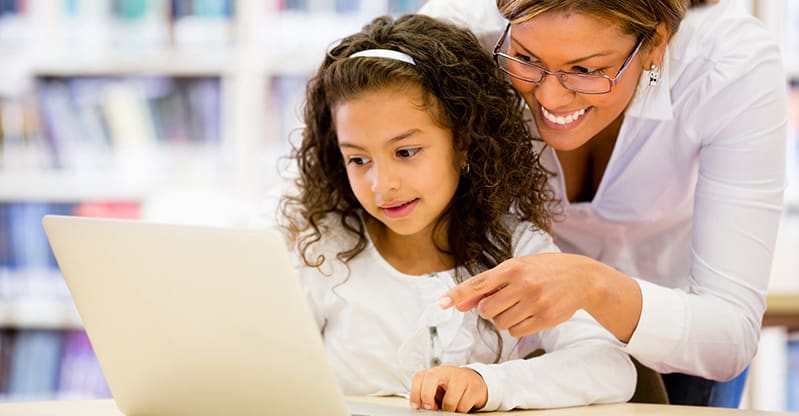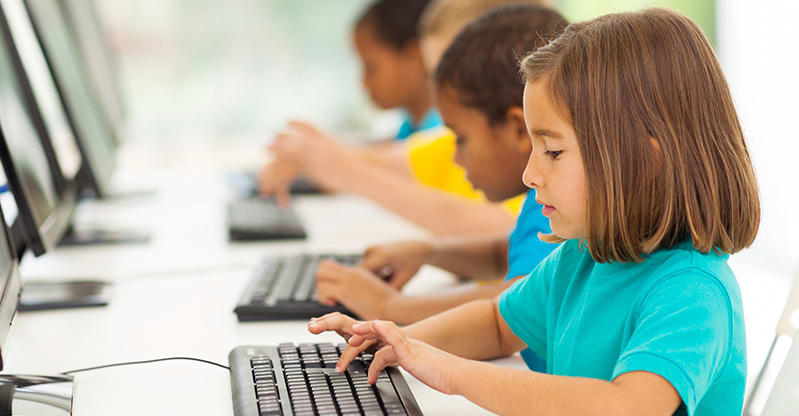Thanks to technology, your child is probably already familiar with more kinds of computers than the ones you’ve used. The changing nature of computers means that kids’ first introduction to computers isn’t a laptop or desktop anymore. If you’ve ever handed a young child your phone, or if your kid has ever asked Alexa to play a video, they’ve interacted with a computer.
But there’s real value in teaching kids how to use an old-school keyboard and mouse computer; they will need to know how to use it for schoolwork. Some activities (like taking a programming language class online) are easier on traditional computers.
So when should you introduce them to computers? And what are some essential basic computer skills for kids? Read on for some vital computer basics for kids.

WHEN SHOULD YOU INTRODUCE YOUR CHILD TO THE COMPUTER?
Based on their lifestyle and relationship with technology, every family will have a slightly different answer to this question.
Some babies will be familiar with computers because they have seen their parents using them. Others won’t see a computer until they’re older. There are a couple of general guidelines, however. You’ll want to introduce computers to kids when:
- They’re old enough to understand at least what a computer is (most children under three will only see the light and noise)
- They’re, at most, old enough to start using computers in school
- You’re present so that you can supervise them
Many psychologists do not recommend that children under the age of 3 be exposed to any type of screen. However, the final decision is for the parents to take, and there are many approaches.
Specifically, this means computers can be introduced to your child between the ages of 3 and 6. You might want to start your child on educational programs or cooperative family games. Anything you do, however, should be introduced with you present. Young children should not be using a computer or learning online without supervision.
 |
| Do a business with < Oman IT Services > WhatsApp: https://wa.link/gwdhhh https://www.youtube.com/@omanitservices548 |
TEACHING YOUR CHILD HOW THE COMPUTER WORKS
The best way to introduce your child to a computer is to start them on a family laptop or desktop rather than a tablet or phone.
Why? This limits the child’s access and allows you to teach them the basics: such as how to turn the computer on and off and how to open and close the software.
But before that, you can show them that most artifacts they interact with daily are also computers. When they realize that even the candy machine they enjoy so much at the nearest strip center is a computer, they’ll be more willing to learn about the subject. They’ll realize that computers are way more than just a fun application of algorithms and that they need it to use almost anything they can find.
Kids will also need to learn how to use traditional computers with keyboards because they will likely use them at school. Learning on an actual computer will help them understand the basics of hardware and software and boost their typing and mouse skills in a way that touchscreens cannot. You may also consider showing your child a video or website about the history of computers for kids, so they have a better understanding of what computers are and how they developed over the years.
At this point, you should also be teaching kids basic computer hygiene, like washing (and thoroughly drying) their hands before using the computer, using gentle hands, and keeping food and drinks away from the keyboard. This will give your child a solid foundation for learning on computers at school and completing homework.

WHAT ARE SOME IMPORTANT COMPUTER SKILLS FOR KIDS?
No matter their interest level in computers, all kids need the same computer skills to succeed at school. After all, most of their schoolwork and homework will be completed on a computer, and as they get older, they may be required to have an email address or specific social media accounts.
TYPING
Good keyboard skills are essential when children are learning at school. Studies show that touch typing increases accuracy and the speed with which kids can type. It’s also best to teach good typing skills at a young age; children pick up skills more quickly than adults, so the sooner kids learn to type, the better.
You can teach a child how to type by yourself, or they can learn to type using specific programs such as Typing Club, a game like Jungle Junior, or a software program like Typing Instructor for Kids 5.0.
When your child gets older, they may ask for an email address to keep in touch with friends, or they may need one for school.
This could happen as soon as the second or third grade when they’re old enough to read and write well (and before joining social media networks). They will, however, need adult guidance, and you’ll need to keep an eye on their inbox and outbox (as well as their spam).
Consider using a program like Outlook, which downloads messages to your machine, rather than a web-based account. This will keep your child off the open Internet and — while they’re still young — lets you download messages first, reading through them before your child does.
A charming exercise you can do to introduce your kids to email is to open an account for them when they’re pretty young. Write them emails, tell them stories about their days, share some feelings with them, let them know how you felt when they gave their very first steps, etc.… Whenever they turn 12 or 13 and are old enough to appreciate such a gesture, provide them with the password to that email and let them own it.
After they learn how to code, something they should understand to create meaningful technological solutions in the future is that there is always a person on the other side of the screen. Technology that doesn’t connect and work for and with people is meaningless. Let them lead the future, let them innovate, let them turn this world into a better place.

ONLINE RESEARCH
As your child gets older, they’ll be using the Internet to search for information for school projects, and here too, they will need support from a grown-up. While your child will probably be old enough to use a computer independently when they’re assigned reports that require research (probably between the ages of 8 and 12), you should help them with their first research projects and teach them how to use search engines.
Research is more than typing a term into a search bar. As you probably already know, not all websites are trustworthy, but your child is still learning. Make sure they learn basic search skills. Your kids will need to know where to find good information, which sites can’t be trusted, and they’ll also have to be monitored if they get off track and end up in another corner of the Internet. (It may help set up parental controls that limit their ability to browse.) Once children understand online research and can work independently, stay close by while they are learning so you can keep an eye on them and answer any questions.
 |
| your business Logo @Oman Graphix <Oman IT Services> WhatsApp: https://wa.link/gwdhhh https://www.youtube.com/@omanitservices548 |
Remember when we used to be their age, we grabbed several Encyclopedia volumes and editions to answer a straightforward question? The same thing happens online. Maintaining internet safety for our children, they should comprehend that the variety of sources they can connect with will enable them to build their point of view on something. It is time to empower our kids to have their own opinions and approaches on different topics, and online research -with the supervision and guidance of a responsible adult- can be a great way to accomplish that.
January 16, 2022 |
January 16, 2022 |
 |
| Do a business with < Oman IT Services > WhatsApp: https://wa.link/gwdhhh https://www.youtube.com/@omanitservices548 |




0 Comments